E-Newsletter



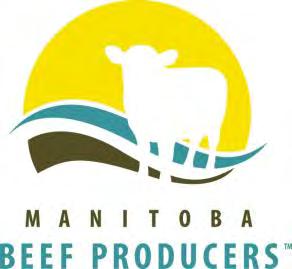
(November 8, 2022 Province of Manitoba News Release) The Manitoba government is unveiling a new water management strategy the first of its kind in nearly 20 years to guide future actions, decisions and investments to protect the province’s water resources and ecosystems while sustainably growing the economy and communities, Premier Heather Stefanson and Environment, Climate and Parks Minister Jeff Wharton announced.
“Our collective water needs are changing. Our growing communities, vibrant agriculture sector and expanding industries all depend on continued access to water,” said Stefanson. “At the same time, climate change and extreme weather, such as floods and droughts, have a significant impact on water availability and security. Manitoba’s new water management strategy balances environmental, social and economic needs, and creates opportunities to partner with industry, communities and all Manitobans to unlock future growth while ensuring the province remains a leader in sustainable water management.”
As Manitoba’s first whole of government water strategy since 2003, the new water management strategy provides a comprehensive framework to conserve and protect the
environment, enhance resiliency, improve water quality and availability and foster economic development opportunities, the premier noted. The water management strategy will help support innovative solutions, best practices and new technologies to help address the shared water needs of Manitobans.
A water action plan for fulfilling the vision and objectives of the strategy will be developed this winter through further engagement with the public and interested stakeholders, the premier added.
“We have heard from Manitobans that developing a priority based strategy now will set the stage for thriving and resilient ecosystems, communities, and our economy,” said Wharton. “The water management strategy is the starting point for this critical work to address water security. Together, we will chart a path to meet the water needs and priorities of Manitoba’s communities and economy in a way that will be resilient and sustainable for generations to come.”
An from MBP November 10, 2022 mbbeef.ca• GRASSFED: "TrueNorthFoodsispartneredwithA&WCanada tosupplyCanadiangrassfedbeefforA&Wsgrassfedburgerprogram.


• SERVICES: Whetheryouareaspecialtyproducerlookingtoget yourproducttoaspecificmarketordistributor,orifyouareproducing commoditylivestockforsale,wecanpartnerwithyou.Fromour multi-speciescapabilitiestoourabilitytohandlesmallervolumes,we offerexcellentcapabilitiesforproducersintheCanadianPrairiesto maximizetheirprofitability.
• FACILITY: Wehaveastate-of-the-artfacilitytoallowusto reachmarketsacrossCanada,theUSA,andbeyond.Weunderstand producersneeds,theircarefortheiranimals,andtheirhonest, straightforwardnature.Callustohearhowwecanworktogethertoget yourproducttomarket.
www.truenorthfoods.ca
Focus areas within the water management strategy incorporate specific strategic objectives to guide and prioritize actions, initiatives and investments including:
• maximizing water resource potential through conservation and efficient water use;
• addressing water infrastructure challenges and opportunities;
• meeting water supply needs of current and future generations sustainably;
• protecting biodiversity and aquatic ecosystem health;
• building Manitoba’s preparedness and resilience to a variable and changing climate;

• protecting the quality and quantity of groundwater;
• protecting and improving surface water quality;
• improving co-ordination of water management and governance across watersheds, basins and aquifers;
• improving data information and knowledge available on water;
• advancing Indigenous inclusion in water management; and
• enhancing engagement and participation of Manitobans in water stewardship.
The Manitoba government’s new water management strategy builds on extensive input
from Manitobans including the Expert Advisory Council, citizen engagement through EngageMB and stakeholder engagement administered through Enterprise Machine Intelligence and Learning Initiative (EMILI). All areas of input recognized water security as both a challenge and a competitive opportunity for communities and industry alike.
“Manitoba is fortunate to have excellent water resources at a time when water security and resilience are a growing factor for companies considering where to invest,” said Ray Bouchard, co chair, Integrated Water Strategy Committee and board chair, EMILI. “In a changing climate, sustainable water management and smart water investments will be a strong part of Manitoba’s competitive advantage in agriculture, industry and future growth sectors.”
The premier and minister noted the strategy builds on a strong foundation of water management enhancements and significant investments in recent years including over $200 million in the Conservation GROW and Wetlands GROW trusts and many actions under the Climate and Green Plan and the Sustainable Watersheds Act.
For a full statement from the premier and the minister, visit: https://manitoba.ca/sd/pubs/water/waterstrat egy_launchstatement.pdf
To read the water management strategy and learn more about next steps visit: https://manitoba.ca/sd/pubs/water/water_mg mt_strategy2022.pdf.
Beef & Forage Days is packed with information and innovative leading experts aimed to help Manitoba beef producers best manage their cattle operations. Find out the latest news on research and production for beef and forage management at this one day meeting.
Date: Wednesday, January 11, 2023
Time: 8:45 a.m. to 3:15 p.m. Place: Austin Community Centre 60 – 1st Ave. Austin MB
Agenda
8:45 a.m. Coffee, registration and view agri-business displays
9:30 a.m Canadian Roundtable for Sustainable Beef
Kristine Tapley, Ducks Unlimited Canada
10:15 a.m Manitoba Beef & Forage Initiatives Programs & Activities


Mary Jane Orr, MBFI Manager
10:45 a.m. Ask the Vet: Animal Health Update
Deanne Wilkinson, Manitoba Agriculture Extension Veterinarian
11:30 a.m. Manitoba Forage and Grassland Association Update
11:45 p.m. Lunch and visit agri-business displays
1:15 p.m. Cattle Market Update and Outlook for 2023
Brenna Grant, Canfax
2:15 p.m. Manitoba Beef Producers Activities and Programs
2:30 p.m. The Benefits of Cover Crops to Improve Soil Health and Provide Livestock Forage
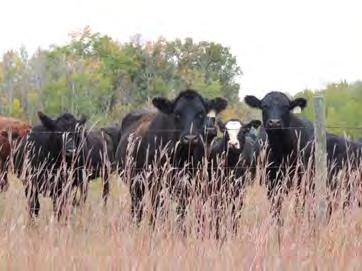
Bart Lardner, University of Saskatchewan
3:15 pm Adjourn
Agri-business booths will be set up. For more information, call the Manitoba Agriculture office in Portage at 204-239-3353.
Date: Tuesday, January 10, 2023 Tuesday, January 10, 2023
Time: 1:00 p.m. 4:00 p.m. 7:00 p.m. 10:00 p.m.
Place: Eriksdale Community Centre Kinsmen Community Centre 22 Railway Ave., Eriksdale, MB 435 Burrows Ave., Grandview, MB
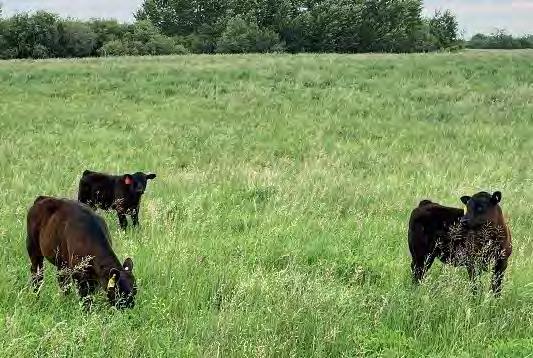
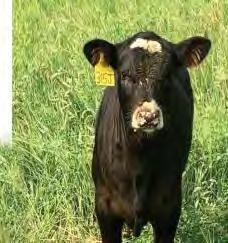
Date: Thursday Jan.12
Time: 9:00 am -12:00 pm Place : Rosa Hall - Shevchenko Ukrainian Centre 19 Church Rd, Rosa, MB

(November 8, 2022 Province of Manitoba News Release) Manitoba Health advises that a Pfizer infant vaccine was recently recommended for use in children aged six months to four years old. Most parents and caregivers who make a first vaccine appointment for a child in this age group should expect the Pfizer infant vaccine will be offered.
This vaccine is being distributed to clinics, pharmacies and vaccine sites across Manitoba and should be available as early as this week. The Pfizer infant vaccine is a three dose series and each dose should be given at least eight weeks apart.
It is recommended that, whenever possible, children receive the same vaccine for each dose. The remaining provincial stock of the Moderna infant vaccine will be used as second doses for those who received that vaccine as a first dose. The National Advisory Committee on Immunization also strongly recommends the Moderna infant vaccine for immunocompromised children. Appointments can continue to be made by using the online booking tool, by contacting the vaccine call centre at (toll free) 1 844 626 8222 (1 844 MAN VACC) or by contacting medical clinics and pharmacies directly. Children must be at least six months of age at the time of their immunization appointment.
While not a substitute for vaccination, Manitobans are reminded that treatments are available for people who are at risk of more serious outcomes from COVID 19. Even people who are fully vaccinated may be eligible for these treatments. Higher risk individuals who develop symptoms should contact a health care provider or Health Links Info Santé at 204 788 8200 or 1 888 315 9257. Treatment must be started within days of symptom onset, so timing is important. For more information about treatment, including eligibility and access, visit: https://manitoba.ca/covid19/treatment/i ndex.html
• Vaccine finder: www.manitoba.ca/covid19/vaccine/fin der.html
• COVID 19 in Manitoba: www.manitoba.ca/COVID19
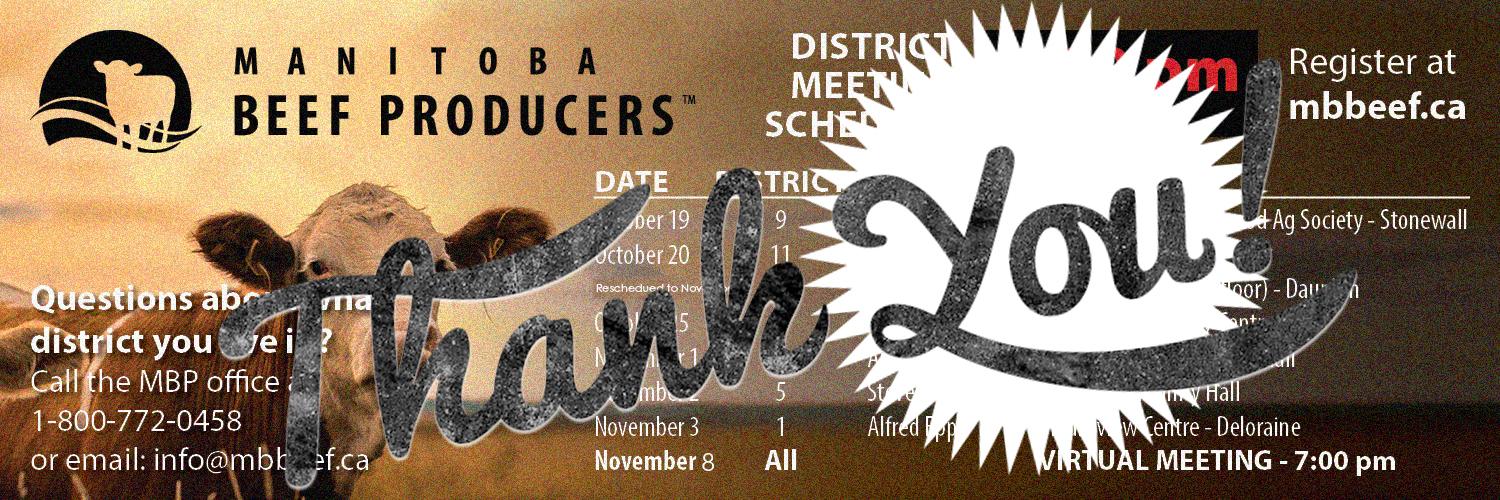
• Vaccine campaign: https://protectmb.ca/ and www.manitoba.ca/vaccine
• Vaccination data: www.health infobase.canada.ca/covid 19/vaccination coverage
• Testing information: www.manitoba.ca/covid19/testing/inde x.html
Provincial legislation prohibits the application of synthetic fertilizer and livestock manure between Nov. 10 and April 10 to prevent nutrient runoff, with limited exceptions if weather conditions permit Manitoba Environment, Climate and Parks has advised that no provincial variance is in effect this fall, so nutrients cannot be applied on or after November 10 due to the expectation of snow cover, frozen soils and below freezing temperatures.
When a regional/province wide variance has not been issued for the winter application of nutrients and an individual producer believes their soil/weather conditions should be considered for a variance, agricultural producers must contact staff in the Nutrient Management Regulation program at nmr@gov.mb.ca or by phone at (204) 945 0002. If an individual wishes to make a formal request for a variance, the request must be provided in writing
by a Professional Agrologist or Certified Crop Adviser.
At any time throughout the winter, emergency situations may occur. Pursuant to Section 14(4) of the Livestock Manure and Mortalities Management Regulation (M.R. 42/98), the director may authorize winter application of manure due to an emergency situation or extenuating circumstance. Examples may include the manure storage facility reaching its capacity or the imminent failure of a manure storage facility. Information on Emergency Manure Spreading Requests is available or by contacting Environmental Approvals Branch at: mmpregistration@gov.mb.ca or by phone at (204)945 8321.
For more information on nutrient application rules, visit: https://www.manitoba.ca/sd/water/lakes beaches rivers/nutrient_management/
(November 10, 2022 Province of Manitoba News Release) Reaffirming its commitment to engage the next generation in the collective fight against climate change, the Manitoba government is inviting youth across the province to apply to the next cohort of the Youth Advisory Council on the Climate and Green Plan, Environment, Climate and Parks Minister Jeff Wharton announced.
“Young people have valuable ideas on mitigating climate change and our government recognizes the tremendous value of their forward thinking perspectives,” said Wharton. “On Youth and Future Generations Day at COP27 the United Nations conference on climate change the Manitoba government is pleased to announce applications are now open for the next cohort of the Youth Advisory Council.”
Applications are open to Manitoba youth who:
• are between 15 and 29 years of age on Jan. 1, 2023;
• represent the diversity of Manitoba;
• are knowledgeable about issues related to the Made in Manitoba Climate and Green Plan;
• demonstrate a proven interest in environmental issues and community engagement;
• are able to engage in respectful, open discussion and be tolerant of conflicting viewpoints; and
• are not employed by the Manitoba government.

The minister noted applications are due at midnight on Nov. 30. The new cohort is expected to be in place in January 2023. Members will serve a one year term until January 2024.
The Youth Advisory Council receives its mandate from, and reports to the minister’s Expert Advisory Council on the Climate and Green Plan. This independent group of experts has a mandate to provide advice and recommendations to the minister on implementing the climate and green plan in such areas as climate mitigation and adaptation, low carbon economy, transportation and energy.
The minister noted the youth council was first established in September 2019, adding the two past cohorts provided critical forward thinking input into several key strategies and recommendations on Manitoba youth’s perspective on climate change, as well as providing input into the Expert Advisory Council’s recommendations on green transportation and a provincial water strategy.
For more information on the Made in Manitoba Climate and Green Plan and to apply for the Youth Advisory Council visit https://manitoba.ca/climateandgreenplan/yac. html.

(Nov. 10, 2022 NCC News Release, Warren, MB) Tall grass prairies are globally rare, iconic to Manitoba and quickly disappearing. That’s why the Nature Conservancy of Canada (NCC) has conserved one of the largest, privately owned tracts of land supporting this endangered ecosystem in the province.
At nearly 2,700 hectares, Lake Ranch represents a large contribution to efforts to ensure that this emblematic and ecologically critical grassland continues to feed and foster the prairie lives that depend on it.
Grassland birds listed as threatened under Canada’s Species at Risk Act, such as the Sprague’s pipit and bobolink, breed in the large expanses of grasslands, while migratory wetland birds, like western grebes, flock to the expansive wetlands along the lake, which makes up part of the globally significant North, West, and East Shoal Lakes Important Bird Area.
The size of this conservation project, less than an hour from Winnipeg, in the Interlake region, will allow NCC to maintain the landscape scale disturbances that are necessary to maintain grassland ecological integrity, such as compatible grazing, prescribed burns and other stewardship actions that will help maintain productive and healthy habitats.
The previous owners, The Lake Ranch Ltd. Group from Germany, recognized the global importance of these grasslands and had a vision of creating an ecological preserve and eco lifestyle area. While past flood events in the area prohibited use of the property as a "natural neighbourhood," they recognized NCC as the group who could bring to life their vision where "nourishing and caring for nature is as important as nourishing and caring for the soul."
The previous owners also wanted to support local economy through Lake Ranch’s continued
agricultural use. The property has been managed as a livestock operation for nearly 100 years. Grasslands still exist on the property because of the relationship between compatible livestock grazing and healthy grasslands.
With the close connection to the nearby Woodlands Community Pasture, there’s an even greater understanding of the importance that healthy grasslands provide to economic security, biodiversity and a connection to past and future generations living in these iconic landscapes. Community pastures are community owned or government lands, which have a long history of supporting livestock farmers by providing high quality grazing in balance with biodiversity and other ecosystem services.
The property will serve as an accessible conservation area for engaging local residents, providing ecotourism opportunities and connecting visitors to nature. The conservation of this project also provides opportunities to foster and steward a relationship with Manitobans and raise awareness that temperate grasslands are the most endangered terrestrial ecosystem on the planet, and of the important role that a grazing based economy plays in maintaining this ecosystem.
This project was made possible by the Government of Canada, through the Natural Heritage Conservation Program, part of Canada’s Nature Fund. NCC also thanks Lake Ranch Ltd. who donated over 20 per cent the value of the Lake Ranch property, MapleCross Fund who made a lead gift to the project, and others who contributed to conserve these lands, including the Richardson Foundation and Jim and Leney Richardson.
The Lake Ranch project marks the start of NCC’s grasslands campaign in Manitoba. In the next five years, we aim to conserve thousands of hectares of one of the world’s rarest terrestrial ecosystems and
invite everyone to discover their connection to nature. Together, through purposeful actions, we have the opportunity to build toward a great good a thriving world. To secure the natural future of projects such as Lake Ranch and other iconic grassland landscapes in the province, NCC is looking to raise $25,000,000.
Grasslands and their associated habitats in Manitoba can sustain our food industries, offer healthy habitat to endangered species such as Dakota skipper, and grow nature based solutions to some of the impacts of climate change and biodiversity loss.
It’s only by working together that we can save Manitoba’s grasslands.
This project showcases how NCC is accelerating the pace of conservation in Canada. In the past two years alone, NCC has influenced the protection of more than 1 million hectares (almost twice the size of Prince Edward Island), coast to coast to coast. Over the next few years, the organization will double its impact by mobilizing Canadians and delivering permanent, large scale conservation.
In the face of rapid biodiversity loss and climate change, nature is our ally. There is no solution to either without nature conservation. When nature thrives, we all thrive.
• Lake Ranch contains intact prairie, forest, wetlands and portions of the East Shoal Lake complex.
• Lake Ranch is one of the largest privately owned tall grass prairie tracts in Manitoba.
• 112 bird species, including eleven shorebird species, have been documented at Lake Ranch and the adjacent lakes.
• The property is home to eight federally and/or provincially listed species, including:
o barn swallow o bobolink o eastern wood pewee o monarch o northern leopard frog o red headed woodpecker o Sprague’s pipit o trumpeter swan o western grebe
• Grasslands store carbon, slow flooding and help filter groundwater.
• Grasslands have evolved to thrive under disturbance, such as grazing and fire.
“Every single project that we do, big or small, is an act of hope, and personally reminds me that we’re not in this alone. It’s not just one ecologist against the world, it’s not the Nature Conservancy of Canada against the world, it’s the world with us wanting these prairie landscapes as part of its future. It just a matter of connecting people to the opportunities to support us.” Cary Hamel, Director of Conservation, Nature Conservancy of Canada Manitoba Region
“The twin crises of climate change and biodiversity loss are two sides of the same coin, and we must tackle them together. By working with partners such as the Nature Conservancy of Canada, we are helping to protect the natural environment in Manitoba and across the country. Protecting lands plays a vital role in helping to halt and reverse biodiversity loss, and contributes to the recovery of species at risk. Through the Natural Heritage Conservation Program, the Government of Canada is making progress toward its goal of conserving a quarter of lands and oceans in Canada by 2025, working toward thirty percent of each by 2030.”
TheHonourable Steven Guilbeault, Minister of Environment and Climate Change
Great Tastes of Manitoba a farm to table collaboration showcasing the nutritious, affordable, delicious foods grown by Manitoba’s farmers. The well known brand reaches consumers through a multi platform approach which includes a website, social media presence, YouTube channel and Manitoba’s longest running locally produced television series broadcast on CTV. We are expanding our team with the addition of a part time Digital Producer for the term of our 34th season, February 2023 – January 2024, with opportunity for renewal for future seasons. Due to the flexible nature of the position, hours will be determined based on the candidate’s strengths and availability, which could be up to 30 hours per week.
Successful applicant would be tasked with managing the Great Tastes of Manitoba digital channels, including updates to greattastesmb.ca and social media content creation. Successful applicants will report directly to the series senior producer, Donalee Jones.
Job Type: Part Time/Term
Compensation: Competitive freelance salary to be negotiated based on duties assigned
Working with the GTOM Senior Producer to develop a targeted digital marketing plan in alignment with the GTOM strategic plan
Working with the GTOM Senior producer to develop social media campaigns, photo, and video assets
Tracking digital marketing metrics, providing recommendations based on results and trend analysis
To solicit sponsorship and advertising and pursue strategic partnerships
Qualifications:
Successful candidate must have permanent residence in the province of Manitoba
Excellent verbal and written communication skills
Excellent organizational skills with the ability to work independently
Post secondary education in marketing, communications, or creative field
Proficiency with Meta Business Suite, YouTube Creator Studio, WordPress, and Google Analytics
Minimum 2 years experience in Sales/Marketing or similar creative field
Illustrated experience with building a successful YouTube following will be considered an asset
Experience or knowledge of agriculture in Manitoba will be considered an asset
Experience or knowledge of culinary arts/food will be considered an asset
Successful candidate must have permanent residence in the province of Manitoba
Benefits of joining our team:
Work independently from home OR at our offices at 509 Century Street (free parking)
Flexible work hours
On the job training and professional development opportunities
Term contract renewal would be negotiated annually as funding allows
Application Process: Please submit a resume and at least three references to Great Tastes of Manitoba Senior Producer, greattastesmb@gmail.com, on or before December 9, 2023.
We thank all those that apply, but only applicants that meet the qualifications will be contacted for an interview
Are you interested in a dynamic role in the field of communications and marketing?
An emergency or disaster can place a tremendous strain on producers, animals, and the food supply chain. Outside of a foreign animal disease outbreak, livestock operations may experience damage and disruption from seasonal events and natural disasters.
While these challenges are difficult to predict, advance preparation can help safeguard the welfare of those involved, ensure business continuity, and encourage a speedy recovery after the unexpected event has passed.
This document has been developed to provide additional emergency guidance for producers and animal caregivers.
Structure Fire and Wildfire 2 Flooding 5
Power Grid and Utilities Failure 7 Severe Drought 9
Livestock Vehicular Transport Accident (Livestock Hauler) 10
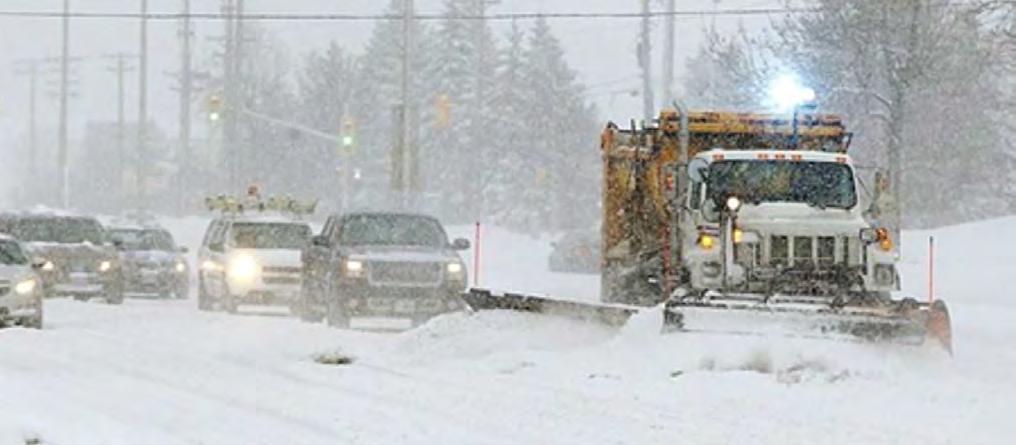
Fires can have a devastating impact on a farm. Whether it’s a small area fire or uncontrolled wildfire, flames can spread across vast tracts of land, posing serious threats to livestock in barns, pens, and pastures.
• Farm buildings, sheds, and residences may be seriously impacted during a fire. These structures often contain materials such as wood, hay, and straw that can act as feedstock and further fuel the blaze.
• The ignition of a fire may be triggered by engine exhaust, exposed wiring, or lighting as well as other on farm heat sources such as combustion of bedding, litter, or hay. It is important to keep flammable materials away from heat sources and to be aware that high moisture levels in bales can contribute to excess heat, mold growth, and loss of dry matter. Fortunately, almost all structure fires are preventable. By being observant and practicing common-sense fire prevention techniques you can help reduce risks.
• Always have professionals perform all wiring and electrical modifications to barns, livestock housing structures and shops
• Prohibit smoking in and around barns
• Store combustibles (hay, shavings, manure, gas, oil, propane, paint, cutting torches, etc.) away from the barn
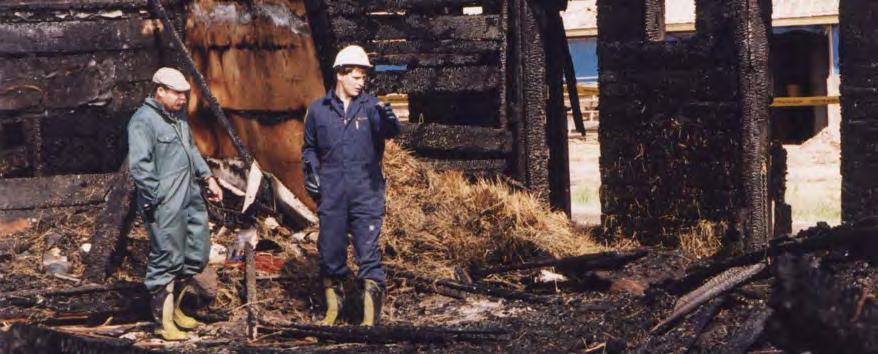
• Minimize the number of heat and electrical appliances in the barn that have the risk of sparking or causing fires
• Grain dust will ignite and explode. Do not try to auger grains during a fire
• Map the location of fire extinguishers, these should be in all barns, shops, and structures that have the potential to catch fire. Fire extinguishers should be easy to find within the structures, and all staff and family members should know where they are located and how to use them
• A structure can be completely engulfed in less than six minutes
• Panicked animals normally will not leave a barn on their own, because they do not fear fire
• Most animals are killed from smoke inhalation and those who do survive rarely recover
• Never put personal safety in jeopardy to save an animal
Horses
• Lead animals from the left-hand side
• Horses are easier to control when blindfolded
• A towel over the horse’s eyes, secured under the halter works well to keep horses from running back into the barn
Cattle
• Try to move cattle in a group instead of one at a time
• Beef cattle are commonly housed outside near or around a barn in groups. Move animals to a separate field away from the barn
• Isolation greatly stresses the animals, and they will generally be more cooperative if moved together
• Dairy cattle should be relocated to a protected area if the fire occurs in winter, as they cannot withstand extreme weather
• Bulls can be extremely dangerous and only people familiar with them should handle them
Swine
• Pig barn fires are very challenging. If numerous pigs are in a barn, they will be almost impossible to evacuate
• Pigs must be confined after removal from a barn, or they will attempt to run back into the burning structure
Poultry
• Due to the constraints and husbandry practices of poultry barns, the birds are almost impossible to evacuate
• Virtually all poultry barn fires result in a 100% loss
• If possible, turn off all power sources to the barn, shop, or any other affected structures
• If the barn roof is on fire, do not enter the structure as there is potential for the roof to collapse
• All severely injured or burned animals must be humanely euthanized as soon as possible following provincial guidelines:
• On-Farm Euthanasia Guidelines for Calves and Cattle
• On-Farm Euthanasia Guidelines for Sheep and Goats
• Practical Guidelines for On-Farm Euthanasia of Poultry
• Pig Euthanasia – On Farm Options
• Euthanasia of Horses
• Wildfires can spread across forests, grasslands, and fields at an astonishing rate. Farms near wildlands/ grasslands or owners that have livestock near these natural areas should be prepared for wildfires and know the steps to minimize risks and losses.
There are several proactive measures that can be completed in advance to prepare producers for a wildfire emergency including:
• Having contact information for prearranged off-farm evacuation sites (lairage points) handy
• Reviewing wildfire history in area
• Identifying and maintaining equipment that may help fight an approaching grassfire or wildfire (e.g., disk, harrow, tractor, water truck)
• Reducing vegetation and wood debris within 10 to 30 meters of farm structures by thinning and pruning
• Creating firebreaks by clearing vegetation and exposing bare soil to help curb the movement of wildfire
• Mapping the location of fire extinguishers, these should be in all barns, shops, and structures that have the potential to catch fire. Fire extinguishers should be easy to find within the structures, and all staff and family members should know where they are located and how to use them
• Predetermining the location evacuation sites and routes that may be used for animal movement and have a map of the identified areas readily available for all staff, family and first responders
• Storing hay, straw, beddings/shaving outside the barn in a dry, covered area, if possible
• Having water and feed readily available or at the pre-arranged lairage site(s) to ensure that all affected livestock have sufficient feed and water
• Creating a detailed inventory of livestock and developing list of emergency contacts prior to any wildfire event
• If in a wildfire susceptible area, procuring and installing some type of irrigation/ sprinkler system to help suppress fire
• Preparing an evacuation kit that includes but is not limited to:
• Supply of feed, supplements, and water for 7 to 10 days
• Blankets, halters, leads, water buckets, feed buckets
• Copies of vaccination records, medical records, and proof of ownership
• Tools
• Cash and credit card
In the lead up to and during a wildfire emergency, producers will try to protect their farms and prevent losses. As you respond to the threat of wildfire consider the following:
• Evacuating employees/visitors to an agreed safe meeting place as required
• Notifying the fire authority immediately. In my area, the number is _______________________
• Assessing the fire and only attempting to contain or extinguish a small fire if it can be done safely
Flooding is a natural and often seasonal hazard that can be extremely disruptive and can pose a threat to animal and human health.
The most common cause of flooding is rain and/or snow melt that accumulates faster than it can be absorbed into the soil, drainage, or water bodies.
Not only can flooding cause immediate issues with rising water levels, but it can also disrupt services and create broader public health concerns.
By assessing the threat of flood and being prepared, producers can improve their readiness for an emergency. The risk of flooding will depend on the geographical location (e.g., proximity to creeks, streams, and rivers) as well as topographical features (e.g., drainage basins, low lying land, etc.).
High Stream Flow Advisor
Flood Watch
Flood Warning
• River levels are rising or likely to rise rapidly, but no major flooding is expected
• Minor flooding is possible
• River levels are rising and will approach or may exceed the banks
• Flooding of areas adjacent to affected rivers may occur
• River levels have exceeded the top of the bank or will surpass it imminently
• Flooding will occur in areas near affected rivers
1. Unconfined animals can usually take care of themselves during a flood
2. The farmer’s goal should be keeping livestock high and dry
3. Your local emergency coordinator can provide up-to-date flood information and forecasts
There are activities that can be completed prior to a flood that will better prepare producers in the event of an emergency including:
• Reviewing local or provincial floodplain map and assessing flooding potential
• Identifying locations where livestock can be moved, on-site and/or off-site, including evacuation route
• Mapping out safe locations and routes
• Identifying livestock haulers that could assist in livestock movement on short notice, if applicable
• Identifying higher ground for equipment relocation (e.g., motors, tractors, tools, etc.), pesticides, fertilizer, or other chemicals
• Identifying electrical power switches/breaker to shut off power to areas where flooding is imminent
• Locating feed, bedding material, medications, etc., in areas unlikely to be flooded

• Considering methods of moving feed and water to low flood risk locations
• Checking that backup generators are in working order and extra fuel is available in the event of a power outage
• Test sump pumps regularly and install a back-up system (for example, battery back-up or generator)
The necessary approach during a flood will depend on various factors including river or stream levels, winter snow load, ground conditions, and current and forecasted precipitation.
It is important to stay informed of situation developments and relocation instructions as they are communicated through online channels, television, radio, and social media. Always follow evacuation orders and ensure human safety first.
Actions to consider if an evacuation order is issued and time permits movement of animals:
• Arrange trucks, trailers, drivers, and handlers to move animals if necessary
• Use pre-arranged route to move livestock to a location where they will be safe from the flood (high ground) whether that be on-farm or off-farm
• Turn off electricity to barns and other structures to prevent fires or electrocutions
• Ensure animals have access to food, clean water, and ample living area
• If there is a possibility that dairy barns may become inundated, drive cattle out of the barn. During rapid rise of water, cattle often refuse to leave the barn and may drown inside if the water rises high enough. For this reason, begin evacuation measures before a state of emergency
• Opening gates and/or cutting fences will allow animals to move and avoid the flood if livestock cannot be moved to a pre-determined safe area. If animals are set free, local authorities should be notified immediately
• Block off narrow passageways where animals would be unable to turn around. A few heavy animals in a narrow dead end can be dangerous
Utility outages are generally unexpected and inconvenient. These downtimes can be triggered by a variety of events, including severe weather, wildfire, and other potential hazards.
Producers should consider the length of time their operations can function without electricity, natural gas, or water. Preparation and appropriate response will minimize the impact of prolonged outages and will help protect your equipment and livestock.
• Look up and down – look for electrical hazards overhead and underground
• Stay back – make sure you’re standing at least 10 meters away from fallen power lines
• Call for help – if you see a power line on the ground, stay back at least 10 meters and call 911

• Determine what critical equipment and facilities rely on electrical power, natural gas, and/or water. Plan for if these utilities are unavailable
• Estimate how long can you operate without the utility
• Determine backup measures and have them available
The following activities may help prepare producers in the event of an emergency:
• Ensure backup generators are available, in working order and are tested regularly
• Have sufficient fuel available to run generator(s) for at least seven days
• Identify locations of electrical breakers, water shut-off, and natural gas/propane shut-off and include on farm site map
• Ensure electrical panels are well-marked and breakers can easily be turned off
• Ensure that all cold and freezer storage for items such as milk, nutrients and vaccines are connected to back-up power
• Test critical equipment with backup power and ensure working as required
• Identify equipment that should be shut off during a power outage and record the sequence for reinstating power
• Determine how livestock will be fed and watered during a power failure
• Identify backup measures to supply heat for animals, if applicable
• Store battery-operated lights in a location that is easily accessible and have fresh batteries on hand
• Create a contact list that includes energy suppliers and electrician details
• Protect sensitive equipment with surge protectors
• Back up computer files regularly
Cattle - beef and dairy
• Lactating cows have an increased requirement for water; necessary steps should be taken to ensure those cows and all other affected cattle do not obtain their water intake solely by eating snow
• Ensure that milking equipment and pumps are powered by generators to prevent milk supplies from spoiling and to reduce the risk of animal mastitis from the inability to perform daily milking activities
• Ensure that water supply is continuous for all cattle. During the wintertime, ensure that water does not freeze in pipes
Horses
• Ensure horses maintain water intake, especially during the summertime as heat stress is deadly to animals
• Low forage consumption increases colic risk
• On an emergency basis horses can use snow as a water source, however supplying them with a source of fresh water during power outages should be a high priority
Poultry
• Provide power to poultry barns immediately as drastic changes in temperature can have a detrimental effect on flock health
• Ensure that power is provided to barns that have electrically powered ventilation systems to ensure proper airflow and prevent oxygen depletion in the barn
• Ensure any water pumps/ watering equipment is connected as drastic changes to water intake can have a detrimental effect on poultry health
Droughts pose a serious threat to livestock and farming operations due to the inability to provide sufficient water to animals and the feed required to keep these animals alive.
Droughts can be categorized based on the population it impacts:
• Meteorological droughts are determined by the degree, duration, and other characteristics of the dry weather period
• Agricultural droughts link the meteorological droughts to agricultural impacts, accounting for soil and plant properties
• Hydrological droughts are related to the effects of dryness on surface and ground-water supplies
Producers can take the following actions to prepare for low water and drought conditions:
• Develop a drought plan. Drought plans should identify the group or class of livestock to be depopulated first if necessary and at what point each group will be removed if the drought persists. This also includes noting any potential toxic or poisonous plants present in the grazing/ pasture lands which may become more prevalent due to the drought conditions
• Formulate a selling policy to help deal with classes of animals that are eligible for sale and the rate at which they are brought to market. Check for animals which are pregnant and that are younger in age.
• Wean calves as early as possible. This is important because this will allow heifers and cows to stay in better body condition
• Combine groups of animals for grazing. This will concentrate more animals in a single herd which decreases the number of paddocks/pastures being used at any one time
• Use instrumentation such as level sensors or rain gauges to measure how much water your crops are receiving
• Ensure the irrigation system doesn’t water faster than the ground can absorb
If low water/ drought conditions arise the following broad points can be applied to help reduce the risk of livestock problems and manage water until a permanent solution can be implemented.
• Consider reducing herd size to reduce the required amount of forage, feed and water required to keep the animals alive and healthy. Consider marketing healthy cattle to reduce stock
• Check for pregnant cows and potentially wean calves off faster to reduce water and feed consumption rates
• Feed and water testing are especially important during times of drought since uncommonly used water sources maybe used (i.e., dugout water)
• Extended rest periods and increased recovery times are necessary to protect plants during dry periods
• Attempt to leave plant residue/ litter on the soil surface to help moisture loss, shading and erosion from the elements to encourage plant forage growth and recuperation
• Locate areas where poisonous plants continue to grow as various species grow faster during drought conditions
• Seeding annuals as an emergency source of forage to supplement perennial pastures may be an option during periods of drought.
Thousands of animals are transported via livestock trucks across Canada, acting as a key and integral process in the farm-to-fork continuum. Though the likelihood of a truck vehicular accident is low, the risk is still present. Livestock transport accident knowledge and understanding is paramount to ensure animal, public and environmental safety.
The following list of general steps to guide action during a livestock vehicle accident:

1) Immediately call 911 to report the accident. In the event that the driver is incapacitated, the first individuals at the scene should establish contact with the authorities
• Communicate any human injuries and indicate the type and estimated number of livestock involved in the accident to the authorities
2) Emergency warning devices i.e., pylons, warning lights, should be set out at the scene and appropriate company or farm personnel should then be notified
3) Attempt to herd/ corral any loose animals to prevent further accidents and/or traffic obstructions
4) If possible, work with first responders to free/ save any livestock trapped as part of the accident
5) Identify any compromised/ injured animals which may not be able to be transported humanely in accordance with Health of Animals Act part XII
6) Contact local veterinarians to determine whether there is a requirement to euthanize animals
7) Follow the direction veterinarians and emergency management authorities to close/ finalize the vehicle rollover situation
Set up containment before removing or releasing animals from trailer
Relocate livestock from holding areas into new trailers calmly
Obtain a head count on all livestock involved in the accident including but not limited to healthy, injured, and deceased livestock
Do not remove animals from wrecked trailer until corralling/ containment area for animals is established
Do not yell, make abrupt or loud noises when handling animals as they may be easily spooked, causing them to be more difficult to handle. Do not use sirens or horns to herd livestock
Do not attempt to remove livestock using machinery, equipment, ropes/winches, etc. Manual extraction techniques are safe and effective for removing livestock Do not become a secondary victim at an accident. All safety protocols must be followed

November 10, 2022
For Immediate Release
(Calgary, AB) Responding to a need brought forward by industry and under the direction of the Board of Directors, Canadian Cattle Identification Agency (CCIA) has just launched an initiative that links non approved Ultra High Frequency Technology (UHF) secondary tags to approved CCIA tags in the Canadian Livestock Tracking System (CLTS), database. This new feature allows UHF users to link the UHF tag to the CCIA tag, so when either tag is read, it points to the same animal in the database.
“This is a positive step forward in supporting UHF currently being used for management purposes and in some cases, it will facilitate cattle exports and provide accurate information for accompanying health papers,” says CCIA’s General Manager, Anne Brunet Burgess.
UHF technology is of interest to some segments of the industry where the technology is being leveraged for better record keeping. Some of the potential advantages of a UHF technology based system include a longer read range and the ability to read many tags at once, making handling more efficient. UHF tags require dedicated reading equipment for this technology. This new feature in the CLTS was made possible with the financial support of Agriculture and Agri Food Canada under the AgriAssurance Program.
The global standard currently in use for electronic livestock identification uses low frequency radio frequency identification (RFID) ear tags for livestock. Discussion regarding the move to a new technology which uses ultra high frequency has been going on for over a decade. While the international standard for a UHF numbering scheme for livestock is still under development, CCIA’s tag pairing initiative makes it possible for industry to get a head start using this new technology. To activate this feature, CLTS account holders must contact CCIA.
The history of tags in Canada goes back to 1998 when the first iteration of the National Identification (ID) program was implemented by CCIA for cattle and bison. For more detail on the evolution of tags and how it all came to be a national program with global ties, see The Story of Tags
Canadian Cattle Identification Agency (CCIA) is led by a Board of Directors representing 15 livestock organizations across Canada, including: livestock producers, auction markets, livestock dealers, feedlots, veterinarians, and processors. CCIA is the responsible administrator of traceability for beef cattle, bison, sheep, and pending regulation cervids and goats in Canada (except for Québec where CCIA only administers bison and goats). 30

For more information, contact: Karen Meades |Communications Manager, CCIA |403 606 2443| kmeades@canadaid.ca
7171 107 Avenue SE, Calgary, AB T2C 5N6 Tel: (403) 275 2083 Fax: (403) 275 1668 Toll free: 1 877 909 2333 www.canadaid.ca
Farm Management Canada, in partnership with MNP, is pleased to offer Canadian beef farmers the opportunity to sign up for our Farm Financial Fluency training program.
From registering for the program, you will benefit from a deeper understanding of your financial situation and the different options available to remain competitive and take calculated risks for continued success. The program will focus on beef production and be applicable to farmers across Canada
Through the Farm Financial Fluency program, you will learn:

✓ Why financial reporting is important and to whom
✓ Key differences between types of financial reporting and who uses what
✓ Different farm business structures and their impact on financial reporting
✓ How to interpret your financial statements (balance sheet, income statement)
✓ Financial ratios and how to use them to analyze risk
✓ How to spot potential financial issues and opportunities
✓ Tools and resources available to manage financial risk

The program consists of three 2 hour sessions spaced out to allow time for reflection and homework. There is also an optional complimentary meeting (60 minutes) with an MNP business advisor to discuss the interpretation of your own financial statements.
WHEN: December 12, 14 + 16 from 1 3p.m. EST
WHERE: Online
COST: $250 + HST
REGISTER: https://FarmFinancialFluencyforCanadianBeefFarmers.eventbrite.ca
You should be available to attend all three sessions to make the most out of the program. Program capacity is 40 registrants, so don’t delay! Register today!
For help with your registration, please contact the program organizer:
Farm Management Canada
Tel: 1 888 232 3262 or (613) 237 9060
Email: info@fmc gac.com